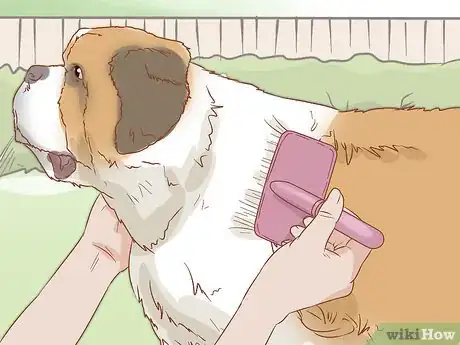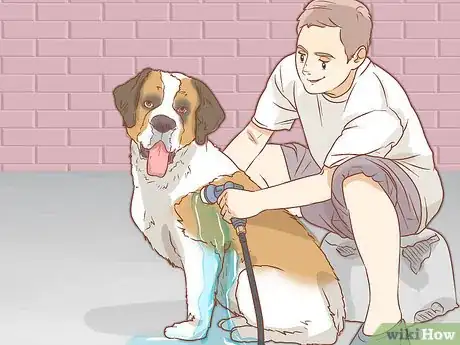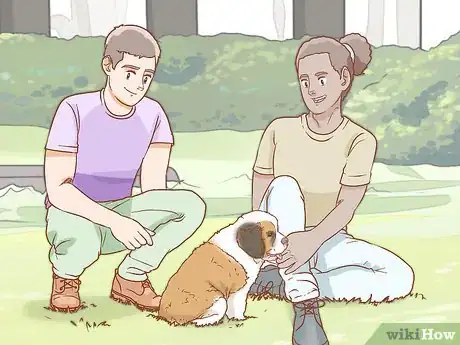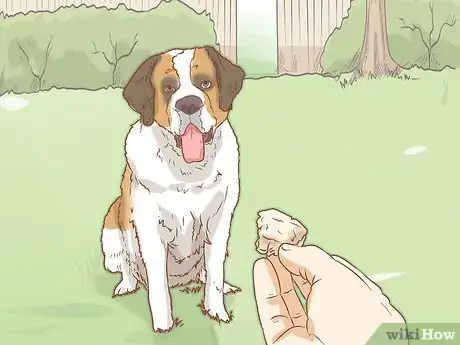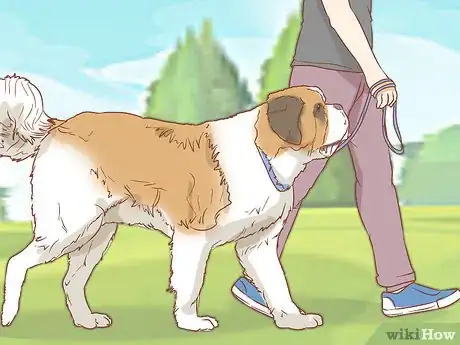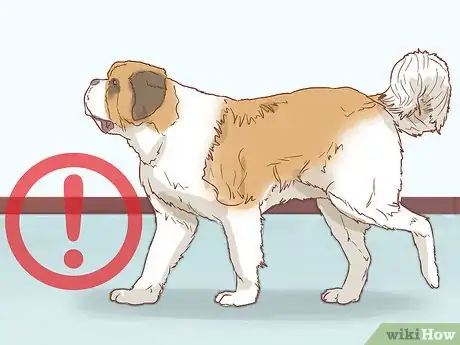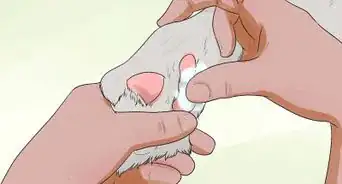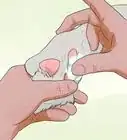This article was co-authored by Cameron Thompsen. Cameron Thompsen is a Dog Trainer and Human Coach, as well as the Owner and Founder of Hope2K9 Foundation. With nearly two decades of experience, she specializes in working with dogs and their owners on behavior issues ranging from severe anxiety, reactivity, as well as aggression and fear-based problems. She works with all dogs at Hope2K9 so that they are fully trained before adoption, and provides lifelong support to dog owners after adoption.
There are 17 references cited in this article, which can be found at the bottom of the page.
wikiHow marks an article as reader-approved once it receives enough positive feedback. In this case, 84% of readers who voted found the article helpful, earning it our reader-approved status.
This article has been viewed 106,873 times.
While the Saint Bernard was originally bred for the purpose of helping lost travelers in the snowy Alps and guarding its namesake, the Hospice Saint Bernard, it’s now a versatile breed loved for its affectionate nature, strength, and loyalty.[1] Not everyone can take care of a Saint Bernard, though: it has some special needs and habits which make it a more high-maintenance pet than many other dogs. For example, unlike some large breeds, the Saint Bernard tolerates outdoor living poorly and craves constant support and human attention. So, whether you’re thinking of adopting a Saint Bernard or you already have one, it’s a good idea to learn about the needs and habits of this lovable breed.
Steps
Feeding and Grooming Your Saint Bernard
-
1Groom your Saint Bernard every day. Saint Bernards have very thick coats which grow rapidly, so you’ll need to dedicate at least ten to fifteen minutes every day to brushing your dog’s coat. Slacking on this daily ritual will lead to matting and poor hygiene, and you risk letting problems such as ticks and skin irritation go undetected.
- Even if you groom your Saint religiously, be prepared for a significant amount of shedding. If you’re a stickler for domestic cleanliness and order, a Saint is probably not the best breed for you, as they’re naturally seasonal shedders that can slough whole bags of fur in a single day.
- There are short-haired Saints as well as the more famous long-haired ones, but even the short-haired Saints will shed and require regular grooming.[2]
-
2Bathe your Saint frequently. Even with regular brushing, your Saint’s dense coat will gather dirt and debris over time. So, while you don’t need to bathe your dog every day, you should make sure to do so every month or so. Use a safe dog-specific shampoo and conditioner, and make sure to clean inside your dog’s ears with a mild ear cleaning solution and cotton balls.
- Be sure to rinse and dry your Saint thoroughly after your bath, as leaving any shampoo or damp spots can cause matting and irritation on the skin. You can towel dry as well as use a blow dryer.
Advertisement -
3Be prepared for lots of drool. The mouths of Saint Bernards are designed in such a way that they produce significant and continuous amounts of drool. Consider this an unavoidable aspect of this breed, so don’t adopt or purchase a Saint if you’re fastidious about your walls, floors, and furniture.
- There have been some recent developments in canine plastic surgery which make it possible to surgically reduce your dog’s salivation, but you probably shouldn’t consider this to be viable option for this innate slobberer.[3]
-
4Purchase a high-quality dog food. Though it can be a bit pricey, try to fit a premium brand of dog food into your budget, as it will help your dog lead a longer, healthier life. Ask your vet for specific recommendations, but, as a general rule, refer to the first five ingredients on the nutrition label as the most important indicators of a food's quality. You'll want to pick a kibble that contains meat as the first ingredient and preferably two meat proteins in the five initial ingredients.[4]
- You can mix some wet food into your dog’s kibble if they like it, but don’t rely on this moist variety too much. Compared to dry food, it contains little nutrition, especially when you consider its relatively high price.
-
5Feed your dog twice or three times a day. Many people assume that, due to their massive size and weight, Saint Bernards must consume huge quantities of food. In fact, due to their low-key temperaments and activity levels, they require less food per pound than most smaller dogs. You should take your dog’s precise weight and measurements when planning portions, but, as a general guideline, you should plan to feed your Saint Bernard between four and eight cups of kibble a day.
- When your Saint Bernard is still a puppy (up to 18 months), you should feed it three times a day, but in adulthood you can cut down to two meals a day.
- Always let your Saint Bernard rest after eating, ideally for several hours. Exercise on a full stomach may increase the risk of bloat (GDV), a potentially lethal condition.
Training and Exercising Your Dog
-
1Start training early. Saint Bernards are intelligent and eager to please, but they can also be stubborn and immature. Their massive size means that bad behaviors like jumping on people can have serious consequences, so it’s important to start training while your Saint is a manageably sized and pliable puppy.[5]
- You should also start socializing at a very young age. Take your new pup to the dog park and introduce it to all your friends and family in order to make them easygoing and friendly.[6]
-
2Don’t punish your dog verbally or physically. It may seem that a harsh tone of voice or swat on the nose when reprimanding your Saint Bernard is no big deal, but think again! While it will probably get your dog to stop whatever behavior they’re doing, it won’t get them to understand that you’re objecting to a particular behavior. Instead, your dog will react fearfully to your agitation and not link the reprimand to a problematic behavior.
- Keeping your voice calm and measured will help you communicate clearly with your Saint Bernard, rather than confusing and frightening it with your fluctuating verbal cues.
- Just because you keep a level head and avoid punishing your dog, doesn’t mean that you should be a pushover. Your Saint wants to obey you, but you have to show that you’re the leader of the pack. Stand erect with your shoulders back and speak in a firm voice in order to establish your status.[7]
-
3Reward positive behavior. Telling your dog “no” when it does something bad rarely works as a training strategy because you're only discouraging bad behaviors rather than encouraging positive ones. Instead of reproaching your dog when it does something wrong, reward it with a treat and verbal praise whenever it does the right thing. Just make sure you deliver your praise and treat within a few seconds so that your dog can link the reward with the behavior you’re encouraging.[8]
- When your Saint does something naughty, think about your response as a correction and not as a punitive measure. A quick collar shake and calm “no” should stop the behavior in its tracks without spooking your dog and disrupting the trust developing between you.[9]
- Consider registering for obedience classes if you feel overwhelmed at the prospect of training your Saint Bernard. You won’t walk away with a K-9 unit pro or a circus dog, but you should notice a pronounced improvement in your dog’s behavior after a six- to eight-week course.
-
4Do activities like cart pulling and obedience trials. Saint Bernards are highly intelligent and powerful animals, and they enjoy performing activities that allow them to utilize these innate skills and assets. It’s also a good way for both you and your Saint to stay active and socialize with other Saint Bernard dogs and their owners.[10]
- If you’re unfamiliar with these activities, you can get involved in them through a local club, such as the Saint Bernard Club of America, the American Kennel Club, or a training school.
-
5Take regular walks. Saint Bernards aren’t extremely playful or energetic, so it’s important to get these lovably lazy monsters moving. Take a couple of brief, moderately paced strolls—about twenty minutes per walk should be sufficient—as well as some shorter runs to get its heart rate up.[11]
- Unlike other large breeds, Saint Bernards don’t require lots of outdoor space in which to run around and play. They’ll enjoy a stroll and a sniff around, but they’re more likely to use your backyard real estate for a nap in the sun than a jog round the perimeter.[12]
- Saint Bernards are prone to heatstroke and exhaustion, so make sure you don’t overexert them. If you’re wanting a running buddy to train for your next 5k, you should look to another breed.[13]
-
6Spend lots of time together. Saint Bernards may look tough and self-sufficient, but they’re actually big babies when it comes to spending time alone. They thrive on sustained and continuous interaction, preferring to be indoors as a member of the family rather than lone wolfing it outside. If you leave them alone for too long, they’re likely to fret and act out with negative, nervous behaviors, so you should consider another breed if you’re a workaholic who is rarely at home.[14]
- When you absolutely must leave your dog alone, supply it with plenty of rubber chew toys. Otherwise, they’ll improvise and find something like a sock, shoe, or couch cushion to distract themselves.[15]
Monitoring Health Concerns
-
1Watch your Saint Bernard’s weight. Due to their relatively low activity levels and placid demeanors, Saint Bernards can be particularly susceptible to weight gain. Excessive weight can lead to joint problems and cardiovascular conditions, so make sure you avoid these health issues by monitoring your dog’s weight. Ask your vet for specific guidelines which take your dog’s size into consideration, but, as a general rule of thumb, your Saint should weight no more than 200 pounds.[16]
- Most dogs can be assessed visually by checking for a waistline and slightly visible ribs, but a Saint Bernard's heavy coat can make this difficult. Rely instead on your scale and the vet’s evaluation.
- Even if you’re feeding your Saint the appropriate portions, your dog can put on weight if you give it too many treats. Remember that treats can be quite calorific, especially when they add up.[17]
-
2Look for signs of limping and eye problems. Saint Bernards are susceptible to some painful joint and bone conditions, as well as eye conditions with potentially serious consequences. They have the highest incidence rate of hip dysplasia of all breeds, as well as bone growth conditions such as osteochondritis and abnormal calcification. You can check for signs of these painful conditions by monitoring your dog’s gait. If you suspect any pain, go to the vet immediately and have them perform diagnostic radiographs.
- Entropion and ectropion—a condition where the dog’s eyelids roll inward or outward—are the most common eye problems for Saint Bernards. It’s a treatable condition, but make sure to nip it in the bud as, left untreated, it can cause eventual blindness.
-
3Help prevent GDV. "Gastric Dilation and Volvulus," informally called bloat, is a major health concern for this breed. When the Saint Bernard's stomach becomes overfull, it can twist, blocking the throat and blood supply. Learn how to reduce this risk:[18]
- Don't let your dog eat or drink large amounts in one sitting. Divide its daily food into two or three meals.
- Never add water to dry food.
- Avoid foods that list fat or oil as one of the first four ingredients.
- Place the food bowl directly on the floor, not raised above ground level.
- If your dog eats quickly, force it to slow down with a specially designed bowl or by placing a large rock in the center of the food.
- Avoid exercising the dog for several hours after eating.
- Watch for a bloated stomach and other symptoms of GDV. If they occur, bring the dog to emergency vet care. GDV can be fatal, so do not delay.
-
4Get yearly check-ups and vaccinations. The average lifespan of a Saint Bernard lifespan is relatively short—usually between 8 and 10 years—so you should be proactive about its health to maximize your time together.[19] Schedule regular appointments with your local vet even if you don’t notice any worrying symptoms, as you can run routine blood screens, check your dog’s weight, and ask about your dietary and exercise regime.[20]
- Hip dysplasia treatments can be pricey, particularly if you opt for a surgical resolution, so you might want to consider purchasing health insurance for your Saint. Ask your vet if they have any recommendations for insurance and explore your options online.
Expert Q&A
-
QuestionWhat should I know before getting a large dog?
 Cameron ThompsenCameron Thompsen is a Dog Trainer and Human Coach, as well as the Owner and Founder of Hope2K9 Foundation. With nearly two decades of experience, she specializes in working with dogs and their owners on behavior issues ranging from severe anxiety, reactivity, as well as aggression and fear-based problems. She works with all dogs at Hope2K9 so that they are fully trained before adoption, and provides lifelong support to dog owners after adoption.
Cameron ThompsenCameron Thompsen is a Dog Trainer and Human Coach, as well as the Owner and Founder of Hope2K9 Foundation. With nearly two decades of experience, she specializes in working with dogs and their owners on behavior issues ranging from severe anxiety, reactivity, as well as aggression and fear-based problems. She works with all dogs at Hope2K9 so that they are fully trained before adoption, and provides lifelong support to dog owners after adoption.
Dog Trainer Know that you will absolutely need to crate train the dog and teach it to walk politely on a leash. These are the two most important things in order to have a long term successful management of a big sized dog.
Know that you will absolutely need to crate train the dog and teach it to walk politely on a leash. These are the two most important things in order to have a long term successful management of a big sized dog. -
QuestionHow do I get my dog to stop destroying everything?
 Cameron ThompsenCameron Thompsen is a Dog Trainer and Human Coach, as well as the Owner and Founder of Hope2K9 Foundation. With nearly two decades of experience, she specializes in working with dogs and their owners on behavior issues ranging from severe anxiety, reactivity, as well as aggression and fear-based problems. She works with all dogs at Hope2K9 so that they are fully trained before adoption, and provides lifelong support to dog owners after adoption.
Cameron ThompsenCameron Thompsen is a Dog Trainer and Human Coach, as well as the Owner and Founder of Hope2K9 Foundation. With nearly two decades of experience, she specializes in working with dogs and their owners on behavior issues ranging from severe anxiety, reactivity, as well as aggression and fear-based problems. She works with all dogs at Hope2K9 so that they are fully trained before adoption, and provides lifelong support to dog owners after adoption.
Dog Trainer Crate training will come in handy to help with this. You gotta teach your dog to be calm and able to self soothe and relax when contained and confined for periods of time, specially when left home alone.
Crate training will come in handy to help with this. You gotta teach your dog to be calm and able to self soothe and relax when contained and confined for periods of time, specially when left home alone.
References
- ↑ http://dogtime.com/dog-breeds/saint-bernard#/slide/1
- ↑ http://saintbernardclub.org/looking-for-a-saint-bernard/general-information/
- ↑ http://www.nbcnews.com/id/6915955/ns/health-pet_health/t/more-pets-getting-nipped-tucked/#.WComoHfMw0Q
- ↑ http://saintbernardclub.org/caring-for-your-saint-bernard/feeding-and-nutrition/part-one-reading-labels/
- ↑ http://dogtime.com/dog-breeds/saint-bernard#/slide/1
- ↑ http://www.vetstreet.com/dogs/saint-bernard#personality
- ↑ http://www.stbernard.org.au/training--behaviour.html
- ↑ http://www.akc.org/content/dog-training/articles/training-your-dog-with-rewards-and-positive-reinforcement/
- ↑ http://www.stbernard.org.au/training--behaviour.html
- ↑ http://www.akc.org/dog-breeds/st-bernard/detail/
- ↑ http://www.petmd.com/dog/breeds/c_dg_saint_bernard
- ↑ http://www.vetstreet.com/dogs/saint-bernard#personality
- ↑ http://dogtime.com/dog-breeds/saint-bernard#/slide/1
- ↑ Cameron Thompsen. Dog Trainer. Expert Interview. 31 March 2022.
- ↑ http://akcsaintbernardpuppies.com/saintbernardpuppiesforsale_.html
- ↑ http://www.vcahospitals.com/main/dog-care/dog-breeds/saint-bernard
- ↑ http://www.vcahospitals.com/main/dog-care/dog-breeds/saint-bernard
- ↑ http://www.petmd.com/blogs/nutritionnuggets/jcoates/2012/may/how_to_feed_dogs_at_risk_for_gdv-16454
- ↑ http://www.globalanimal.org/2013/09/24/about-dog-breeds-saint-bernard/108633/
- ↑ Cameron Thompsen. Dog Trainer. Expert Interview. 31 March 2022.
About This Article
To care for a saint bernard, keep in mind that saint bernards aren't very energetic, so taking your dog on a couple of casual 20-minute walks and a brief run every day should be enough. Avoid taking your saint bernard on long runs or overexerting it since the breed is prone to heat stroke and exhaustion. You should also spend 10-15 minutes a day brushing your saint bernard's coat so it doesn't get matted or dirty. For more tips from our Veterinary co-author, like how to feed a saint bernard, read on!
